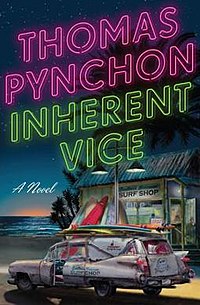 While this may only be significant to previous Vice-readers Andy and Zeke (okay, who am I kidding, its only significant to me, but I digress), perhaps my favorite thing about Thomas Pynchon's sprawling, drug-and-surf noir Inherent Vice is that it is set in my hometown. Okay, Gordita Beach is made up, but Manhattan Beach (my hometown) is mentioned by name as being a neighbor city, as are Manhattan Beach neighbor cities Hermosa Beach, Redondo Beach, El Segundo, and Torrance. The Manhattan Beach neighborhoods of El Porto and the Tree Section (where my parents house is) are mentioned by name, as are streets like Sepulveda and Artesia, and even my high school (Mira Costa High) gets a shout out. Granted, the yuppified, multi-million dollar home Manhattan Beach is a far cry from how it was in the 60's setting of the novel, but still, I thought that was neat. Plenty of novels are set in NYC or London or Chicago or the Greater Los Angeles area, it gives me a little thrill to read one set in my backyard.
While this may only be significant to previous Vice-readers Andy and Zeke (okay, who am I kidding, its only significant to me, but I digress), perhaps my favorite thing about Thomas Pynchon's sprawling, drug-and-surf noir Inherent Vice is that it is set in my hometown. Okay, Gordita Beach is made up, but Manhattan Beach (my hometown) is mentioned by name as being a neighbor city, as are Manhattan Beach neighbor cities Hermosa Beach, Redondo Beach, El Segundo, and Torrance. The Manhattan Beach neighborhoods of El Porto and the Tree Section (where my parents house is) are mentioned by name, as are streets like Sepulveda and Artesia, and even my high school (Mira Costa High) gets a shout out. Granted, the yuppified, multi-million dollar home Manhattan Beach is a far cry from how it was in the 60's setting of the novel, but still, I thought that was neat. Plenty of novels are set in NYC or London or Chicago or the Greater Los Angeles area, it gives me a little thrill to read one set in my backyard.When I say that was my favorite thing about the novel, that might be bit understatement, but it really is not a compliment. While I like Pynchon's writing style, his flair for colorful characters and dialogue, and the way he captures the pervading sense of dread and end-of-an-era-ness that surrounded LA after the (oft refrenced in the novel) Manson murders, the book felt about 100 pages too long and about 45 characters too big. The central noir mystery gets lost after a few chapters, so much so that I didn't even notice when it was solved at first, which happens maybe 2/3 of the way through the book. That mystery is of course replaced by a bigger one, but, you know what? Neither are that mysterious. The fun part of the book is watching PI Larry "Doc" Sportello wander around the South Bay in a pot haze, dodging or failing to dodge the various people who wish him ill or want something from him. But after a while, it starts to feel as if Pynchon had a list of his infamously silly and descriptive names and refused to finish the book before he managed to use every single one of them (some favorites include Sauncho Smilax, Riggs Warbling, Bigfoot Bjornsen, and Vincent Indelicato). Mostly I was ready to be done with the book long before I was, and that's never a good sign.
No comments:
Post a Comment